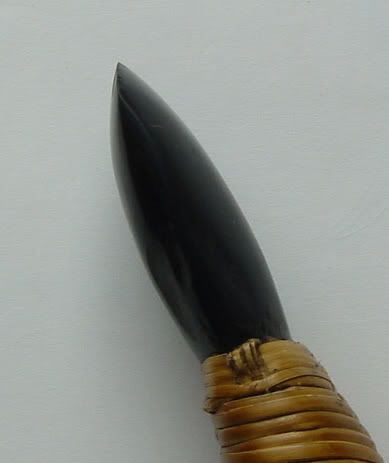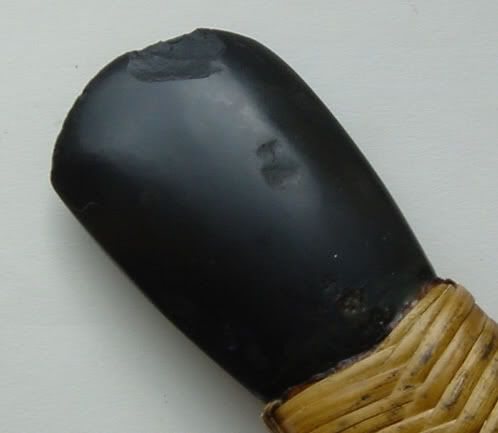
 |
|
|
#1 |
|
Member
Join Date: Dec 2004
Location: What is still UK
Posts: 5,806
|
I recently came across a number Papuan artifacts. Out of the whole lot two pieces are good. There were some splendid arrows but had been cut down and damaged. This came with a fine bow from a chap who's father was an aircraft engineer in the 50s and 60s working in the region. Okay it is not antique but it is the real deal. The work is very fine the grinding of the stone and woven grass is really rather special. It is also enormous 63cm across the top 59cm from the halft tip to top. I have taken the picture with the flash on so it is rather shiny, that is my foot in the picture. Real antique pieces from the highland interior must be rather rare. Better pics tomorrow the bow will be ready to show as well.

|
|
|

|
|
|
#2 |
|
Member
Join Date: Dec 2004
Posts: 1,247
|
Nice axe, Tim
I like the spike handle. All the better to stick it into the thatching or the ground, I'd guess? F |
|
|

|
|
|
#3 |
|
Member
Join Date: Dec 2004
Location: What is still UK
Posts: 5,806
|
There is a right way to do things
 . The weaving wraps the whole thing seamlessly. The stone has a fine finish. . The weaving wraps the whole thing seamlessly. The stone has a fine finish.    
|
|
|

|
|
|
#4 |
|
Member
Join Date: Dec 2004
Location: Italia
Posts: 1,243
|
Hi Tim, Hhow thick is the blade?
|
|
|

|
|
|
#5 |
|
Member
Join Date: Dec 2004
Location: What is still UK
Posts: 5,806
|
The thickest part is 15mm. I also got an adze but it is all mucked up with glue by the original collector. The best thing I can do really is just get the stone out with some acetone and keep that.
|
|
|

|
|
|
#6 |
|
Member
Join Date: Dec 2004
Location: What is still UK
Posts: 5,806
|
The stone could be older and remounted when needed.
|
|
|

|
|
|
#7 |
|
Member
Join Date: Dec 2004
Location: What is still UK
Posts: 5,806
|
I also got this an axe not an adze as I mentioned earlier. I was of a mind to take it apart but thought lets just have a go at the glue showing around the blade with some petrochemicals and acetone. Nothing happened!!!
 this is an organic glue. Then with close inspection the on the rest of the item, this glue was clearly applied before the binding. As I got these ridiclously cheap I gave a lump of wood a good hard whack just for fun this is an organic glue. Then with close inspection the on the rest of the item, this glue was clearly applied before the binding. As I got these ridiclously cheap I gave a lump of wood a good hard whack just for fun  . You would not want to be hit by this thing. As good light is fading It will be tomorrow before I can show some more detailed pictures. There is another axe like thing that has a bone blade I will also look at to. . You would not want to be hit by this thing. As good light is fading It will be tomorrow before I can show some more detailed pictures. There is another axe like thing that has a bone blade I will also look at to.
|
|
|

|
|
|
#8 |
|
Member
Join Date: Dec 2004
Location: Italia
Posts: 1,243
|
Nice Tim! Could you post some close up of the blade as you did for the first one.... Thank you
 
|
|
|

|
|
|
#9 |
|
Member
Join Date: Dec 2004
Location: What is still UK
Posts: 5,806
|
It may be a polyvinyl wood glue? which is solvent resistant. Would be a good trade item like powder paints for body decoration, going to a big singsing. Traditional weapon construction and use getting a modern help. I will poke the stuff about and get some pictures up latter. This link is very interesting. Could be an organic glue? The Mount Hagen peoples world changed rapidly but the traditional weapon and fighting methords would not change over night.
http://www.omnexus4adhesives.com/adh...als.aspx?id=49 |
|
|

|
|
|
#10 |
|
Member
Join Date: Dec 2004
Location: What is still UK
Posts: 5,806
|
I have examined the glue here with x10 glass and made a scrape with a sharp probe and it is not a polyvinyl adhesive. It is some sort of resinous plant extract/gum slightly crystalline like Gum Arab.
 Pictures of the blade. Approx 9cm long, 5.5cm wide. The thickness 3cm. The head of the axe is 41cm long from the tip of the handle to the top centre is 60cm a great force could be lent to a blow from this weapon.    This extract about the Enga from the highlands is very interesting. Tribal Conflict Tribal conflicts are common using crude clubs and steel bush knives, occasionally employing the use of shields made from corrugated sheeting. The usual method of engagement is for both warring parties to line up opposite each other, spend several hours verbally abusing each other, with small rushes towards and away from the enemy being made - increasing in boldness. Eventually, a critical point is reached and the battle begins in earnest. Observing a tribal fight in progress is possible, so long as the observer remains an impartial non-combatant. Sadly, high-powered rifles, home made shotguns and sidearms are becoming more and more popular weapons in Enga, both for tribal warfare and for raskol activities. Sniper tactics have become a more popular method of settling disputes. When projectile weaponry is utilised in a traditional tribal fight the death toll is significantly higher. This also presents additional hazards for those interested in observing a tribal fight in progress. It is recommended that the observer position themselves well out of the line of fire. Employing the use of a foxhole for protection is an excellent measure, as is the wearing of ballistic armour. I wonder how an axe like this was actually used. Close range with two hands striking with either end, blade, handle end and indeed the other end of the blade housing? or just delivering devastating axe blows? Last edited by Tim Simmons; 25th July 2007 at 10:51 AM. |
|
|

|
|
|
#11 |
|
Member
Join Date: Dec 2004
Location: What is still UK
Posts: 5,806
|
I have been looking around on the net and discovered that the export of stone axes pre 1960 is prohibited. I wonder how this relates to the items I have obtained? Is it more a case of if it looks right then you cannot take it out of the country. I wonder when this rule was made 1970s? There must be somebody out there with more info. An axe might have been made November 1959 but collected January 1960?
|
|
|

|
|
|
#12 |
|
Member
Join Date: Dec 2004
Posts: 1,247
|
Hi Tim,
A brief account that might shed light on the law. David Attenborough wrote a book called Journeys to the Past back in the 1981 about his expeditions to Papua New Guinea as a young film-maker. Some time in the '50's, he visited the Mt. Hagen axe makers, and filmed them for the BBC. When he visited, the community was switching from their traditional stone axes to steel axes for everyday use, and the stone axes were becoming lighter and more decorative. The stone axes had a traditional use as bride-price, so they kept making them, but they no longer had to be functional. My guess on the age issue then, is one of functionality. If it's heavy, the edge has been retouched, and there are signs of use and/or wear, then it's probably pre-60's. Since they stored axes in the thatch of their huts, if it's heavily smoke stained, it may well be pre-60's. If it's light, clean, and not too sharp, it's more likely to be post '60's, and was made for show rather than work. My 0.02 cents, F |
|
|

|
|
|
#13 |
|
Member
Join Date: Dec 2004
Location: What is still UK
Posts: 5,806
|
I think I have just sliped under the collectors ok wire
 . .
|
|
|

|
|
|
#14 |
|
Member
Join Date: Dec 2004
Location: What is still UK
Posts: 5,806
|
This stone is a bit well you decide, you can see file marks on it.
http://www.michaeldlong.net/Ko-Bespo...n/E1/52/105630 |
|
|

|
|
|
#15 |
|
Member
Join Date: Dec 2004
Location: What is still UK
Posts: 5,806
|
|
|
|

|
 |
|
|